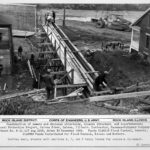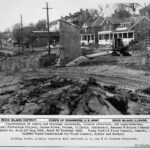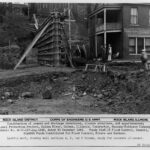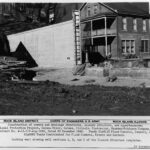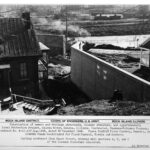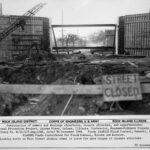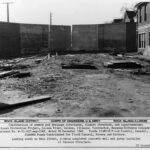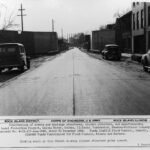Fun Facts about Galena, Illinois
Galena Quiz
This quiz was published in the September 27, 1941 edition of the Galena Daily Gazette. How well can you do?
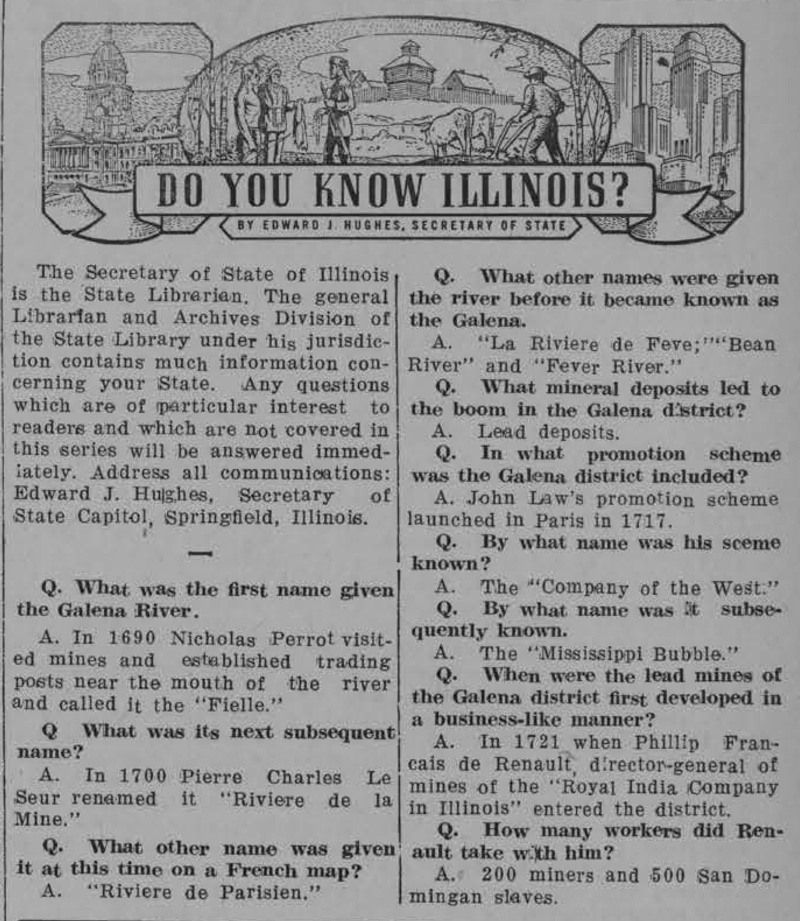
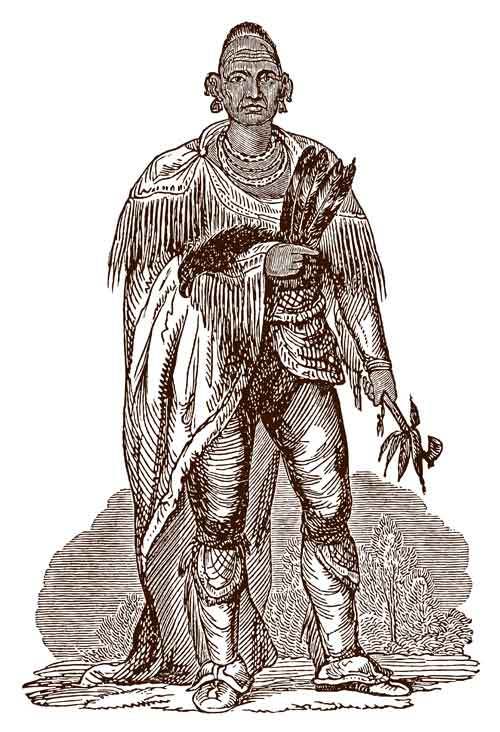
"Ma-ca-tai-me-she-kia-kiak"
Sauk Chief Black Hawk
Native American Trading Post
From the writings of the earliest pioneers, we know the site where Galena now stands was a trading post inhabited by the Sac (Sauk) and Fox (Meskwaki) nations, who traded with the Ho-Chunk (Winnebago), Potawatomi, and Menominee tribes. They mined lead mostly from the surface, and Black Hawk mentions the lead mines in his autobiography.
The indigenous people left behind effigy mounds, including a Thunderbird effigy at Casper Bluff dating over 1,000 years ago, proof the area was populated for millennia.
Lead from the Galena area has been found in native burials as far away as the East Coast and Southwest. It was used mainly for decoration, and had spiritual significance to the indigenous people.
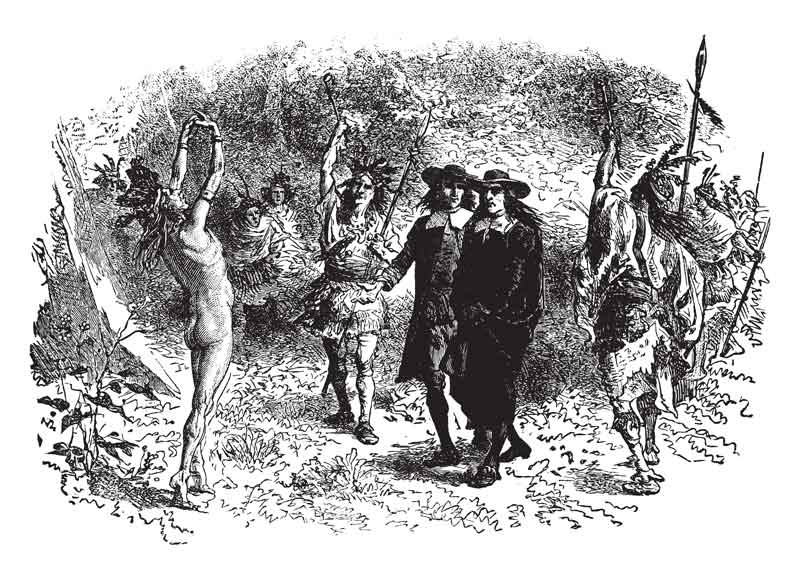
"La Pointe"
French maps from as far back as 1687 show lead deposits where Galena now sits. Sac and Fox were mining and trading lead with other native nations, and the French exploited this network.
Julian Dubuque came 100 years later and famously leased the "mines of Spain" on the Iowa side of the river. He married the daughter of a local native chief, and set about exploiting the natives to enrich himself from the trade of lead and furs. An insurrection forced him to retreat to St. Louis for a while, but he eventually returned and resumed his trading network.
It is not known if Julian Dubuque ever set foot in what is now Galena, but he wrote of "La Pointe," and was familiar with the site and activities in the area.
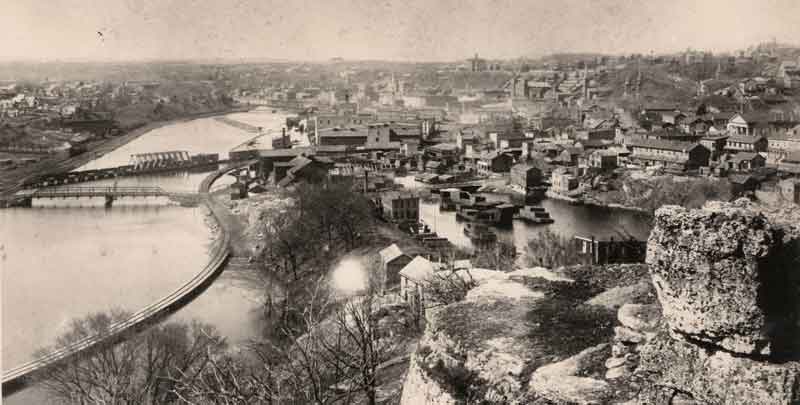
January's Point
Thomas January and his wife Mary Martin arrived in Galena about 1821. Mary is believed to be the first white woman to live in Galena, and also the first to be buried in Galena. She died in 1823 of cholera, and was buried in their yard (customary at the time). This was at the corner of Bench, Franklin, and Diagonal Streets.
After her death, Thomas returned to Kentucky for a year. Upon returning, he found the streets had been widened and her grave was now under the street. Her body was exhumed and returned to Kentucky for burial with her family.
Thomas died in 1828, likely from cholera. He was buried in the Old City Cemetery on Dodge Street.
The harsh winters drove a lot of miners to St. Louis each year before the river froze and prevented commerce to the north. Residents who stayed braved harsh cold and limited food supplies, which would become more and more problematic as winter dragged on.
In 1825, lead leases started to require working the land 5 consecutive days each week, instituted to force the miners to stay through the winter. This was meant to help the local economy, preventing the miners from spending their earnings in St. Louis. Read more about Galena's lead lease history.
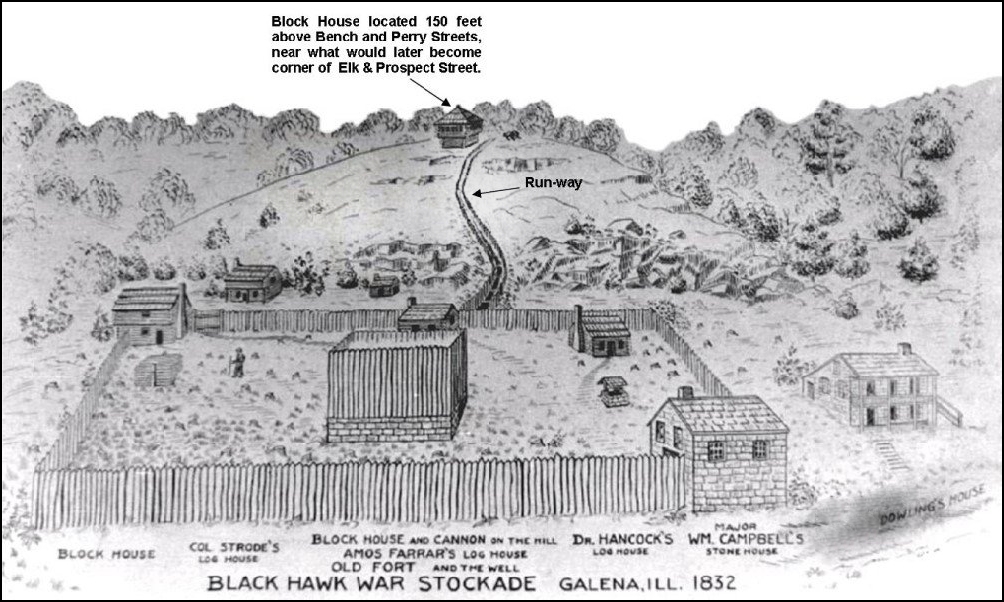
Population Boom
In 1823, Dr. Moses Meeker brought 43 people to Galena to setup a smelting furnace. He conducted a census in August, counting 74 "men, women, and children" and "about 500 Indians." Thus the Meeker party more than doubled the white population, and that was only the beginning of the boom. It is noteworthy that Meeker did not bother to count the actual number of natives, and also that he didn't consider them "men, women, and children," a widespread attitude that would prove fatal for the indigenous people. Read more about Dr. Moses Meeker.
When the Gratiots arrived in December, 1824, "they found themselves in the settlement then called 'January's Point' before the hard cold northern winter was upon them. Three cabins, some rude wooden shacks, and about five hundred white men comprised the village; this did not include the Indians' camps nearby. " Read more about the Gratiots.
By 1828 the population of Galena was estimated to be about 10,000 people. Galena became the largest steamboat port on the Mississippi River between St. Louis and St. Paul. The primary export was lead, and goods were imported from all over the world to fill the shops in Galena's rapidly growing commercial district.
The population dropped during the Winnebago War in 1830 and the Black Hawk War in 1832-33, but then skyrocketed once the Native Americans were removed from the area. Some report the peak population being 15,000 people.
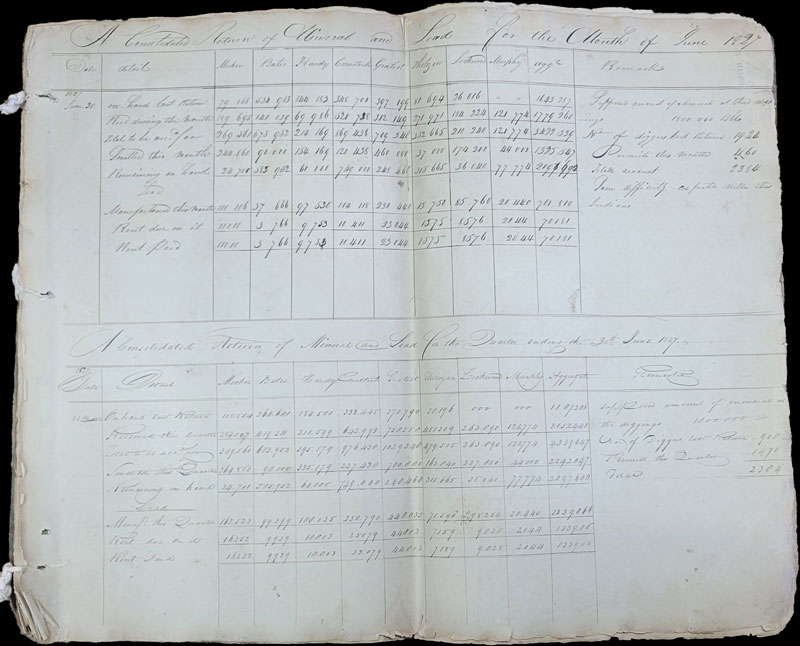
Mineral and Lead Journal from June of 1827, showing over 3,000,000 pounds of ore were received at the 8 licensed smelters during the second quarter of 1827 from a total of 2,384 permits granted to lead mines, resulting in 701,000 pounds of manufactured lead.
"Some difficulty expected from the Indians" written in the margin.
Platted and Named Galena
In 1807, the Federal Land Office was established to determine which lands would be sold to settlers and which would be reserved for leasing to miners.
1n 1826, Galena was platted and formally established. At a town meeting on December 27th in an unnamed tavern, the name was voted on and "Galena" won by a single vote.
The number of lead leases in 1825 and 1826 was 419; in 1827 it mushroomed to 2,384 permits.
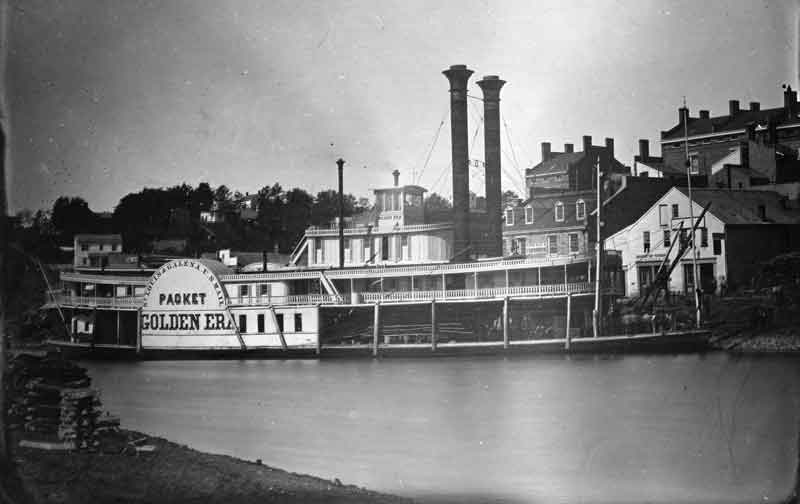
Steamboat Central
Galena was the largest port on the Mississippi between St. Louis, Missouri, and St. Paul, Minnesota. It is believed that all traffic between those two cities would stop in Galena for a respite or to refuel.
The first steam powered vessel to navigate the upper Mississippi was the Virginia in 1823. It briefly docked on "Colonel Johnson's crude wharf" at "January's Point" before continuing to Fort Snelling, near St. Paul, Minnesota.
There are ambiguous references to where the Virginia actually docked. According to the 1937 Writer's Guild booklet the Virginia ascended the Galena River to dock at January's Point, but according to the writings of Constantine Beltrami, passenger and chronicler of the journey, the Virginia merely docked at the mouth of the Fever River.
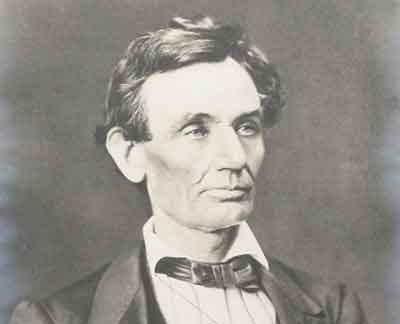
Abraham Lincoln
On July 23, 1856 Abraham Lincoln spoke from the DeSoto House balcony in support of John Fremont for president. The newly formed Republican party was rumored to be "dis-unionist," to which the young lawyer spoke:
“All this talk about the dissolution of the Union is humbug, nothing but folly. We won’t dissolve the Union and you shant.”
Ulysses S Grant
In April of 1860, Captain Ulysses S. Grant and his family arrived aboard the steamboat Itasca to begin their life in Galena. Captain Grant was a graduate of West Point who served in the Mexican American War. He had retired from military duty and had been given a small farm in Missouri by his father-in-law Frederick Dent. It turned out that farming was not one of Grant's areas of expertise, and he eventually gave it up.
Captain Grant's father, Jesse R Grant, owned a leather store in Galena and Ulysses, having failed at farming, moved his family to Galena where he was to take over the store from his brother who was slowly dying of "consumption." This agreement between Jesse and Ulysses was not announced publicly in respect for the dignity of his brother.
When the Civil War broke out, a meeting was held in Galena where it was decided that Galena would stand with the US and raise a militia to join the war effort. Captain Ulysses S. Grant was elected to train the militia.
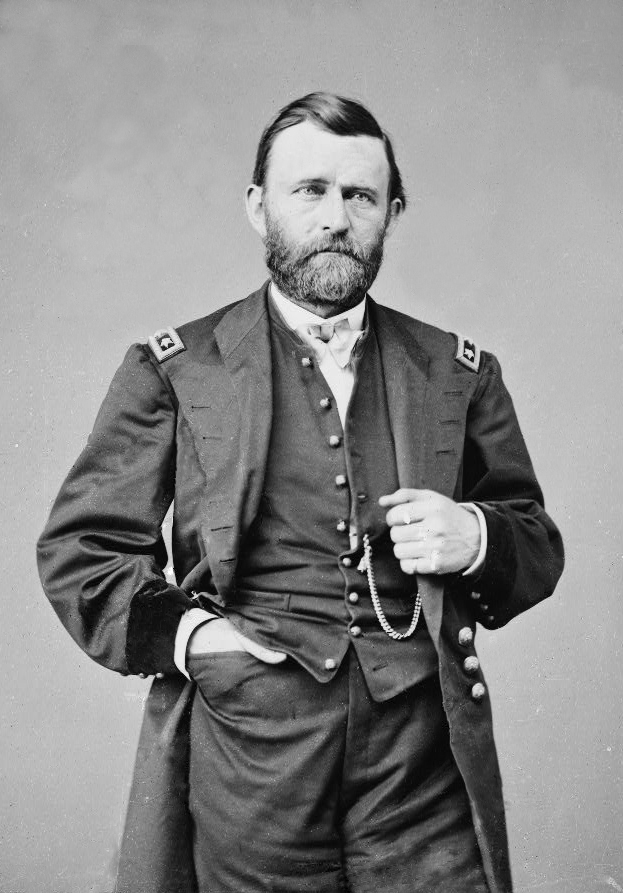
When the time came for the militia to join the US Army in Springfield, Ulysses went along to try to secure a commission in the regular army, having changed his mind about entering the war. He was unsuccessful at securing any such commission, and headed back to Galena resigned to watch the war from the sidelines. Army appointments were highly political, and Grant had neither contacts nor a commanding presence, being small in stature, shabbily dressed and generally low in appearance.
Grant's fate would take an about face when one of the companies he trained demanded their commanding officer be removed. This was an unusual event that the Army did not quite know how to handle; on the one hand being treasonous for soldiers to disobey their commanding officer, but also finding their concerns to be true - the officer being a drunkard who inflicted severe punishments on his men for minor offenses. The soldiers insisted that Grant, who had trained them and earned their respect and admiration, be brought back to lead them. Thus Grant left Galena again, this time with the rank of General.
Five years later, General Ulysses S. Grant would lead the Army of the Potomac in the capture of Robert E. Lee and the Army of Northern Virginia, effectively ending the plight of the Confederacy, although the war would continue for another year.
Eight years after arriving in Galena with no fanfare and little money, Ulysses S. Grant would become the 18th President of the United States of America.
Decline
Steamboats got bigger, the Galena River silted in, and the once prosperous City of Galena saw an end to the steamboats docked on Water Street.
The railroads built their hub in Dunleith (East Dubuque) and Dubuque, Iowa, further sealing Galena's fate. A long period of decline ensued, lasting into the 20th century.

Zinc Mining
Zinc had always been a cast-off by-product of lead mining, but became valuable enough to warrant to resumption of mining in the area in the late 19th and early 20th centuries, but it did not last.
Mines were opened once again during World War II to extract zinc. This would be short lived, with most mines being permanently closed by the 1950s, and the last one shuttering about 1970.
Levee and Flood Gates
During the 1940s, local resident Leo Allen was elected to congress, and thanks to his efforts the Army Corps of Engineers constructed the levee and flood gates that have protected Galena from the ravages of floods until the present day.
Click a thumbnail below to see pictures from the creation of the famous "Flood Gates."
Tourism as Commerce
Thanks to our most famous resident, Ulysses S Grant, and the home presented to him at the end of the Civil War by citizens of Galena - and subsequently gifted to the City of Galena by Grant's grandchildren, Galena has always been a stop for tourists eager to learn more about the unlikely President.
During the late 1950s and into the 1960s, Galena's leaders recognized the value of tourism to Galena's economy, and the rich history that could be revealed to travelers of all ages. A tour of homes was started, with residents opening up their homes to locals and tourists alike to catch a glimpse of the 19th century architecture, housewares, and clothing. Galena's stunning variety of architectural styles brought visitors from all over the US to see the Federal, Colonial, Greek Revival, Victorian, Italianate, and many other styles of architecture that line Galena's streets.
By 1980, tens of thousands of visitors were coming to Galena in the summer months, aka "tourist season."
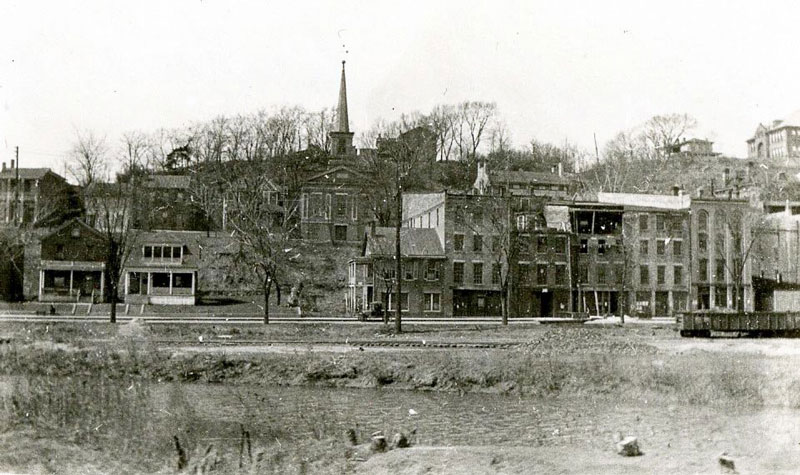
Riverside Drive: 5 buildings on right demolished in 1960s. Flood Gates now stand in the gap seen in photo.
Urban Destruction
In the 1950s and 1960s, buildings on Main Street were crumbling due to abandonment, neglect, and the soft Galena bricks used in their construction. Seen as a public health hazard, whole blocks of Galena's main street were raised - enraging many Galena residents, including one Frank Einsweiler, who would become mayor and lead efforts to halt future demolition and put ordinances in place to preserve Galena's historical structures.
Frank Einsweiler would remain Galena's mayor for four terms, and is credited with inventing the Galena we see today - although he had a lot of help from many other like-minded citizens.
Historic Preservation
During the 1980s, Galena found many new investors interested in rehabilitating the old buildings on her Main Street. Some would gut the buildings of their treasures, leading to the collapse of the Coatsworth Building (one time home of the Grant Leather Store) and near-collapse of the DeSoto House and St Louis Buildings.
Despite these setbacks, Galena experienced a complete revitalization of her Main Street buildings, followed by new streets, water and sewer treatment plants, and an overwhelming increase in tourism.
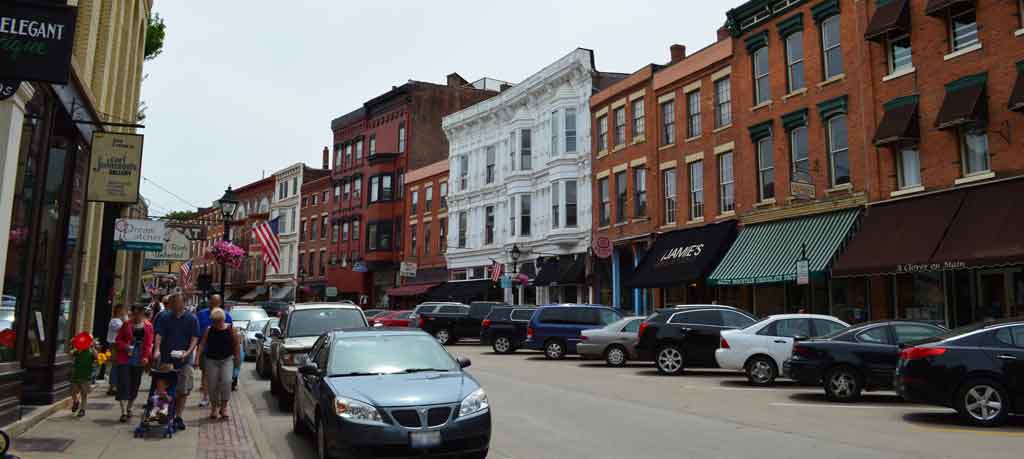
Tourism Boom
Today, Galena sees an estimated 2 million+ visitors each and every year. No longer just a "season" of summer months, tourists flock to Galena every month of the year.
Some come for shopping and dining; others for golf, hiking, skiing, fishing, and hunting. Most enjoy the serenity of the rolling hills and the 19th century feel of Main Street and the historic district, giving modern day travelers a taste of America's 19th century culture.
Important Names in Galena, Illinois History
Julien Dubuque - early settler who mined near Dubuque, wrote of "La Pointe" and likely visited the mines
Thomas January - first to bring his wife to the "frontier" settlement in 1822, she died of cholera in 1833
Francois Bouthillier - opened a trading post on east bank of Fever River
Moses Meeker - brought settlers on a keel boat from Ohio in 1823
Hezekiel Gear - lead magnate of dubious background and methods
Amos Farrar - early settler, lead miner, smelter
Henry Gratiot - arrived in 1824, founded town of Gratiot, Wisconsin
John Dowling - oldest known house and trading post that is still standing, built about 1826
Nicholas Dowling - son of John, prosperous trader who left mansion on Bench Street, large obelisk in St Michael Cemetery
Daniel Smith Harris - built first steamboat on Fever River, the "Jo Daviess," also built, piloted, and captained the "Grey Eagle", "Grey Eagle II", and "War Eagle."
Abraham Lincoln - spoke from balcony of DeSoto in 1856
Ulysses S Grant - arrived in 1860 as a failed farmer, left in 1868 as President of the United States
Elihu Washburne - influential congressman and kingmaker, helped Lincoln and Grant ascend to White House
Orrin Smith - steamboat entrepreneur who ran boats from St. Louis to Fort Snelling (Prairie Du Chien) with stops in Galena. Founder of Winona, Minnesota
H H Kohlsaat - newspaper magnate who spent childhood in Galena, gifted "Grant, Our Citizen" statue in Grant Park, "Peace in Union" painting by Thomas Nast that hangs in the Galena History Museum
Charles Scheerer - beloved mayor and champion of Turner Hall who died on its lawn after collapsing inside
Frank Einsweiler - mayor who oversaw the historical preservation renaissance in the 1970s, credited with saving Galena's Main Street from total destruction, creating the tourism mecca we see today
